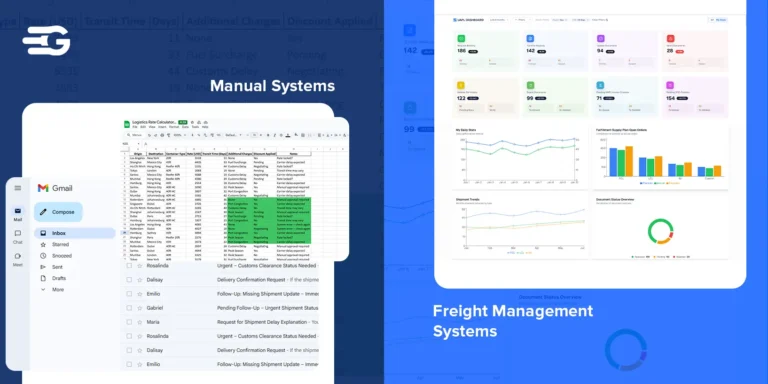What is Warehouse Management? Benefits, Processes, & Strategies
Warehouse management encompasses the principles and processes involved in running the day-to-day operations of a warehouse. This includes receiving, organizing warehouse space, scheduling labor, managing inventory, and fulfilling orders.
Effective warehouse management ensures efficient operations, reduces costs, and enhances customer satisfaction. As supply chains grow more complex, optimizing warehouse functions becomes crucial for maintaining smooth and cost-effective logistics.
Proper warehouse management not only streamlines internal processes but also positively impacts the entire supply chain by enhancing inventory accuracy and minimizing operational delays.
Key Processes in Warehouse Management
Managing a warehouse efficiently involves several interconnected processes. Each step ensures smooth operations, minimizes errors, and enhances operational efficiency. Understanding these key processes helps businesses develop strategies to optimize their warehouse operations.
Receiving and Inspection
Receiving and inspecting incoming goods is the first step in warehouse management. It involves accepting products, verifying them against purchase orders, and conducting quality checks.
Proper inspection during receiving reduces the risk of inventory discrepancies and ensures that defective items are identified early, minimizing future issues. Utilizing barcode scanning and RFID technology during receiving improves accuracy and speeds up the process.
Inventory Storage and Organization
Organizing inventory efficiently is crucial for maximizing space and maintaining accessibility. This process involves implementing storage solutions such as slotting, shelving, and layout optimization to ensure seamless operations.
Efficient warehouse layout planning not only improves space utilization but also minimizes picking time, increasing overall productivity.
Order Picking and Packing
Picking and packing are essential for order fulfillment. Selecting items from inventory and preparing them for shipment requires efficiency to meet delivery expectations. Incorporating techniques like batch picking, zone picking, and wave picking can significantly reduce the time spent in this phase. Proper packing procedures also help prevent damage during transit.
Shipping and Distribution
Shipping and distribution involve dispatching orders to customers. This process requires coordination to ensure timely and accurate delivery while minimizing shipping costs.
Efficient routing and scheduling play a critical role, as do partnerships with reliable carriers. Real-time tracking and automated notifications enhance customer transparency.
Returns Management
Returns are a key part of warehouse management, requiring inspection, restocking, or disposal. Efficient returns handling maintains inventory accuracy and reduces disruptions. Implementing reverse logistics practices ensures that returned products are processed quickly, minimizing stock discrepancies.
Benefits of Effective Warehouse Management
Effective warehouse management offers numerous advantages, from reducing costs to improving customer satisfaction. Leveraging WMS software and automated solutions can maximize these benefits.
- Improved Efficiency: Streamlined processes reduce operational delays and enhance throughput.
- Cost Reduction: Optimized inventory levels and reduced waste lower expenses and minimize storage costs.
- Enhanced Accuracy: Precise inventory tracking minimizes errors and misplacements.
- Better Customer Service: Timely order fulfillment and real-time tracking boost customer satisfaction.
- Scalability: Efficient systems easily accommodate business growth and changing demands.
Strategies for Optimizing Warehouse Management
To enhance warehouse efficiency, businesses can adopt various strategies tailored to their operational needs. Integrating technology solutions and employing best practices are crucial steps.
Implementing a Warehouse Management System (WMS)
A Warehouse Management System (WMS) helps companies control daily warehouse operations efficiently, from receiving to dispatching. Integrating a WMS boosts inventory control, order accuracy, and labor efficiency by automating repetitive tasks.
Adopting Lean Inventory Practices
Lean practices focus on reducing excess inventory, cutting holding costs, and improving turnover rates. Techniques like Just-in-Time (JIT) inventory help reduce waste and maintain optimal stock levels.
Utilizing Automation and Technology
Incorporating technology like barcode scanners, RFID, and automated storage systems improves accuracy and efficiency, reducing manual workload. Automated order fulfillment systems and robotic picking also streamline operations.
Continuous Training and Development
Training ensures warehouse staff are knowledgeable about best practices and new technologies. Regular development leads to higher productivity and fewer errors. Encouraging cross-training enhances flexibility in handling diverse tasks.
Challenges in Warehouse Management
Despite its benefits, warehouse management poses several challenges that businesses must address for optimal performance. Understanding these challenges helps develop better solutions.
- Labor Shortages: Finding skilled warehouse staff can be challenging, especially during peak seasons.
- Inventory Inaccuracy: Differences between actual stock and recorded data can cause issues, leading to stockouts or overstocking.
- Space Constraints: Limited warehouse space can hinder operations, making layout optimization crucial.
- Technology Integration: Implementing new systems without disrupting existing processes can be complex, requiring careful planning.
Future Trends in Warehouse Management
Warehouse management is evolving with new technologies and practices that enhance efficiency and sustainability. Staying updated with these trends is crucial for long-term success.
- Increased Automation: Robotics and AI are increasingly used to automate repetitive tasks, reducing manual errors.
- Data-Driven Decision Making: Analytics are helping forecast demand, optimize stock levels, and improve order accuracy.
- Sustainability Initiatives: More warehouses are adopting eco-friendly practices, including green packaging and energy-efficient lighting.
- Omnichannel Fulfillment: Adapting to fulfill orders from multiple sales channels is becoming essential for meeting customer expectations.
For more insights, check out our Ultimate Guide to Supply Chain Management and related articles on Warehouse Automation Technologies and Inventory Management Best Practices.
FAQs
What are the key functions of warehouse management?
Warehouse management involves various functions, including receiving, storage, order processing, inventory control, shipping, and returns management. These functions ensure efficient flow of goods, maintain inventory accuracy, and optimize order fulfillment.
How does warehouse management impact supply chain efficiency?
Effective warehouse management directly impacts supply chain efficiency by reducing delays, minimizing inventory discrepancies, and ensuring timely order processing. It enhances the overall flow of goods, leading to better customer satisfaction and lower operational costs.
What technologies are used in modern warehouse management?
Modern warehouses utilize technologies like Warehouse Management Systems (WMS), barcode scanners, RFID, automated guided vehicles (AGVs), and robotic picking systems. These technologies increase accuracy, speed up operations, and reduce manual errors.
How can small businesses implement effective warehouse management?
Small businesses can enhance warehouse management by adopting affordable WMS solutions, using barcode systems for inventory tracking, and implementing lean practices to minimize waste. Regular staff training and efficient space utilization also play vital roles in maintaining productivity.






